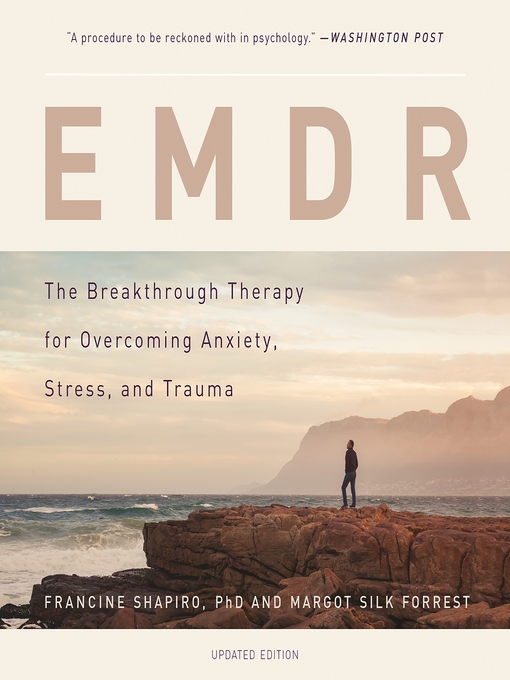EMDR
The Breakthrough Therapy for Overcoming Anxiety, Stress, and Trauma
-
Creators
-
Publisher
-
Release date
February 18, 2020 -
Formats
-
OverDrive Listen audiobook
- ISBN: 9781549151613
- File size: 346396 KB
- Duration: 12:01:39
-
-
Languages
- English
-
Levels
- Lexile® Measure: 1090
- Text Difficulty: 7-9
-
Reviews
-
Publisher's Weekly
March 3, 1997
EMDR, or eye movement desensitization and reprocessing, is a new, nontraditional, very short-term therapy for treating trauma victims that utilizes rhythmical stimulation such as eye movements or hand taps. Shapiro, a clinical psychologist and fellow at the Mental Research Institute in Palo Alto, Calif., who developed the approach, reports cases in which as few as three 90-minute EMDR sessions have relieved patients' disabling anxiety. Explaining how she developed the technique in 1987, Shapiro describes the treatment, theorizes about why it works and cites supporting research. She suggests that the rhythmical stimulation inherent in the process jump starts and accelerates the brain's information processing system to enable the victims to begin to process the traumatic experiences in which they have been stuck so that natural healing can begin. Writer Forrest presents gripping case studies from numerous EMDR-trained therapists to demonstrate the effectiveness of the technique--among others, a Vietnam veteran with post-traumatic stress, a child with night terrors, a rape victim and a mother still nearly paralyzed with grief a year after her son's death. Other studies report success helping drug addicts and the terminally ill. -
Library Journal
April 15, 1997
EMDR (Eye Movement Desensitization and Reprocessing) is a controversial method of psychotherapy used for treating posttraumatic stress syndrome and anxiety disorders. These two books provide an overview of EMDR for the general reader. Supporters claim that EMDR releases traumatic memories locked in the brain, accelerates recovery, and reduces stress; opponents point out that a neurological basis for this theory has yet to be established. These two new books on EMRR chiefly contain case histories and descriptions of the therapy; both warn against unauthorized use by therapists not trained by the EMDR Institute. Parnell, a clinical psychologist and senior EMDR Institute facilitator, claims a transcendent focus for EMDR, leading to "objective forgiveness" of oneself and the perpetrator of the trauma. Shapiro, who developed EMDR in 1989, documents research supporting EMDR, citing both controlled and uncontrolled studies and listing 12 populations where EMDR has been effectively used as a form of treatment. Both books are recommended for popular psychology collections, though Shapiro's book is the preferred choice for readers who may wish to follow up on EMDR research.--Lucille M. Boone, San Jose P.L. Cal. -
Booklist
March 1, 1997
Eye Movement Desensitization and Reprocessing (EMDR) is a hot psychotherapy topic these days, so many will be interested in what Shapiro, the therapist who discovered it, has to say. The process is based on the movement of a patient's eyes following the therapist's hand as the patient focuses on a major or minor disturbing event but consists, overall, of eight parts: the treatment plan, preparation, assessment, desensitization, installation, body scan, closure, and reevaluation. EMDR works much faster than the oral psychotherapeutic method, and the patient therefore pays less and gets back to business sooner. It has reportedly freed many from the effects of such experiences as child abuse, rape, natural disasters, and accidents. Shapiro does not know how it works but offers several theories. In any event, EMDR is available from some 20,000 therapists who have studied its basics. Shapiro concludes with advice on finding one of the 20,000. ((Reviewed March 1, 1997))(Reprinted with permission of Booklist, copyright 1997, American Library Association.)
-
Formats
- OverDrive Listen audiobook
subjects
Languages
- English
Levels
- Lexile® Measure:1090
- Text Difficulty:7-9
Loading
Why is availability limited?
×Availability can change throughout the month based on the library's budget. You can still place a hold on the title, and your hold will be automatically filled as soon as the title is available again.
The Kindle Book format for this title is not supported on:
×Read-along ebook
×The OverDrive Read format of this ebook has professional narration that plays while you read in your browser. Learn more here.



